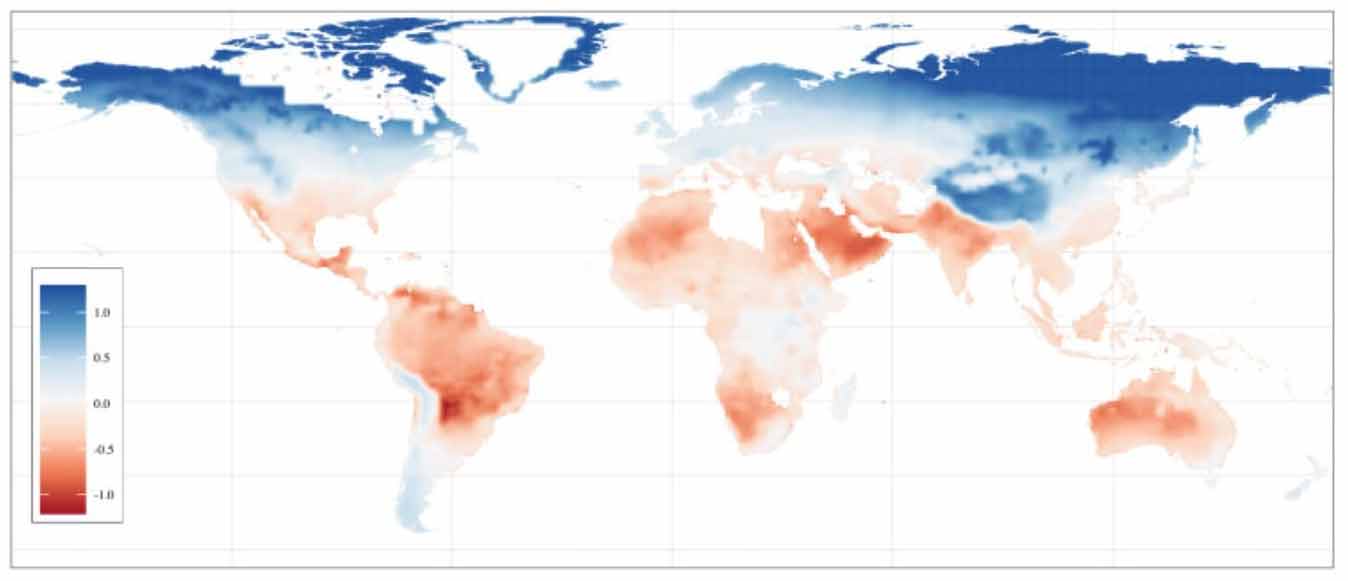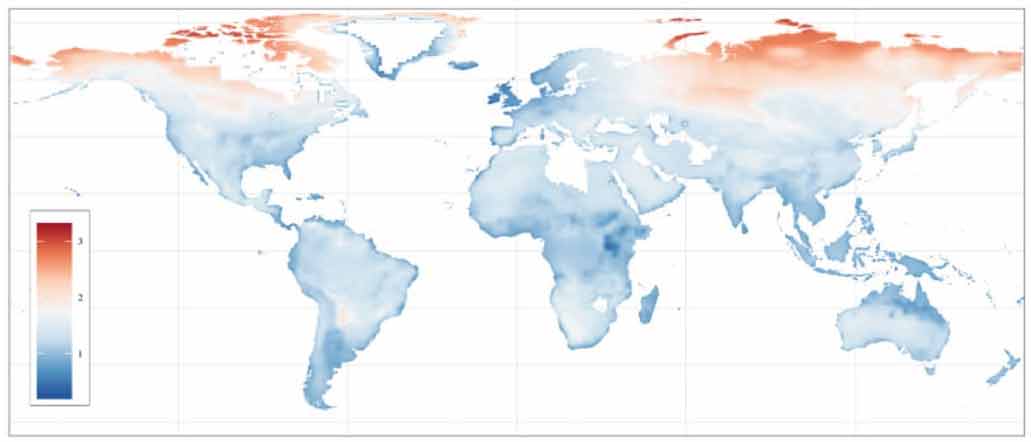Climate change is a defining challenge of our times. In this post, Peri and Robert-Nicoud introduce a special issue of the ‘Journal of Economic Geography’ on climate change, which provides foundations for well-informed policymaking by addressing two main themes of the economic geography of climate change. First, climate change yields heterogeneous effects across space, and second, a crucial aspect of human adaptation to climate change is geographic mobility.
The planet is likely to be at least 3°C warmer in 2100 than at the time of writing even if immediate and radical action is undertaken (Tollefson 2020). Climate change is thus a defining challenge of our times (the loss of biodiversity is just as pressing). The scenarios issued by the Intergovernmental Panel on Climate Change (IPCC) provide a sophisticated modelling of the complex interactions between human activity and climate. Yet, their modelling of heterogeneous spatial effects and of the multiple margins affected by this phenomenon remains rather simplistic (Cruz and Rossi-Hansberg 2021a, 2021b).
Addressing Oswald and Stern’s (2019) concern and following up recent efforts such as the special issue of the Economic Policy journal (Azmat et al. 2020), we collect five papers in a new special issue of the Journal of Economic Geography (JoEG) that contribute to addressing these shortcomings and address important aspects of two main themes of the economic geography of climate change1. First, climate change brings effects that are heterogeneous across space. In turn, some regions of the globe will lose more population and output per capita than others, and some may even be better off as a result. Several papers in this special issue document this heterogeneity at a fine spatial scale. For instance, Figure 1 reports the predicted change in temperature from a 1°C increase in the global temperature at a 1° x 1° resolution for the whole world in the year 22002. The resulting heterogeneity is striking. Second, humans (and other species) will have to adapt in order to live. Margins of actions to slow down climate change include making consumption habits and production processes less carbon- and methane-intensive. Several papers in this special issue emphasise adaptation via migration and geographic mobility. In particular, the papers emphasise how lack of mobility could contribute to worsening the socioeconomic costs of climate change.
Figure 1. Predicted change in temperature from a 1⁰C increase in global temperature in year 2200
In the first study in the special issue, Conte et al. (2021a, see also Conte et al. 2021b) speak to both themes outlined above, and we organise this post following their view. The authors introduce a quantitative dynamic spatial growth model featuring, as in the pioneering work of William Nordhaus (1993), the two-way relationships among economic activity, carbon emissions, and temperature. Importantly, the analysis allows for two sectors (agriculture and non-agriculture) that are heterogeneously sensitive to temperature, and for a very fine spatial disaggregation – the authors feed their model with data on population, temperature, and sectoral output at a 1° x 1° resolution for the whole world, and with increases in the carbon stock and global temperatures that follow the carbon-intensive IPCC scenario known as Representative Concentration Pathway 8.5. With the model thus calibrated, they let it run forward for 200 years to quantify the spatially heterogeneous effects of climate change on population, GDP (gross domestic product) per capita, and the production mix of agriculture and non-agriculture outputs. They also stress the roles of trade and migration in mitigating or amplifying the losses induced by climate changes for each 1° x 1° spatial unit.
Heterogeneous spatial effects of climate change
The initial scenario in Conte et al. (2021a) assumes that frictions to the mobility of populations and of goods are constant over time. Their model predicts that Scandinavia, Finland, Siberia, and northern Canada gain populations and see increases in income per capita, while North Africa, the Arabian Peninsula, northern India, Brazil, and Central America lose on both counts. Figure 2, which reproduces Figure 6 in their paper, reports the effect of climate change on predicted population in 2200. Agriculture becomes spatially more concentrated and shifts towards Central Asia, China, and Canada. These scenarios imply substantial movement of populations within and across countries, especially if trade is costly. Therefore, impediments to mobility may produce substantially less efficient transitions.
Figure 2. Effect of climate change on predicted population in 2200 (log differences)

Notes: (i) The figure displays the logarithm of predicted 2200 population relative to predicted population under no climate change. (ii) Regions in dark blue are predicted to more than double their population; regions in dark red are predicted to lose more than half of their population.
The paper by Castells-Quitana et al. (2021) complements this work in two ways. First, it offers a retrospective regression analysis to quantify effects of past climate change on rural-urban migration (see also Peri and Sasahara 2019a, 2019b), whereas Conte et al. (2021a) is mainly an exercise in forecasting. Second, it studies the relationship between the evolution of rainfall and temperature on the urbanisation rates of countries and on the structure of large cities over a long period of time (1950-2015). Importantly, they allow for heterogeneous effects among low-, middle-, and high-income countries, and study the effects on the whole urban structure of countries, as well as urban size, density, and form. They find that worsening climate conditions (higher temperature and lower rainfall) are associated with higher urbanisation rates in countries with unfavourable climate initial conditions, and that these effects are especially strong in developing countries and affect the density and growth of cities of all dimensions, including the largest metropolitan areas.
Another important aspect, complementary to the economic effect of climate change, is its effect on local social tensions and conflicts. The paper by Bosetti et al. (2021) analyses whether cross-border migration influenced the link between temperature increases and conflicts for 126 countries over the period 1960-2000. On one hand, increased temperatures and more frequent droughts affect the probability of local conflict, by increasing local scarcity of resources (for example, Hsiang et al. (2011)). On the other hand, economic models of migration such as Conte et al. (2021a) show that mobility attenuates economic losses due to the drop in productivity caused by climate change. Bosetti et al. combine these two insights and document that the probability of civil conflict is positively correlated with temperature in poor countries, and that this correlation is especially strong in countries with low propensity to emigrate. Emigration works as an ‘escape valve’ in times of economic duress. Reducing population pressure in areas of developing countries experiencing losses in agricultural productivity seems to be an effective way to reduce the risk that those turn into local conflict.
Not much of what has been explored so far considers the effects of climate changes on fertility. Addressing this issue is the paper by Grimm (2021), which studies the relationship between climate shocks and the demographic transition in the US for the period 1870-1930. The author documents a positive relationship between the variance in rainfall of an area and its fertility differentials between farm and non-farm households. In rural societies, child labour provides additional resources when climate change and uncertainty increase variation in agricultural productivity; rural families may thus increase fertility. However, this mechanism does not operate in urban families.
Climate change leads to rising sea levels and to more frequent hurricanes and typhoons. Coastal areas are at particular risk3. Using an approach conceptually close to the one in Conte et al. (2021a), Desmet et al. (2021) estimate the economic costs of coastal flooding. The paper by Indaco et al. (2021) in the JoEG special issue complements that paper by documenting the effect of Hurricane Sandy on New York City (NYC) business. The 2012 flooding led to a heterogeneous reduction in employment (about 4% on average) and wages (about 2% on average), with larger effects in Brooklyn and Queens than in Manhattan. These heterogeneous effects reflect heterogeneity in the severity of flooding and of industry composition.
Margins of adaptation to climate change
Desmet et al. (2021) develop a model in the same family as Conte et al. (2021a) and estimate that the economic loss due to coastal flooding in 2200 increases from 0.11% of real income when the migration response is allowed, to 4.5% when it is not. Three other studies in this special issue also focus on the role of migration as an adaptation mechanism to climate change.
Castells-Quitana et al. (2021) document emigration from rural areas to cities within country boundaries, and focus on mobility as a force affecting the urbanisation consequences of climate change. Bosetti et al. (2021) analyse how cross-border migration influences the link between global warming and conflicts for 126 countries over the period 1960-20004. Emigration attenuates the effect of rising temperatures on the probability of armed conflict, while it does not increase probability of conflict in neighbouring (immigration) countries.
The margin of mobility is crucial also for businesses and employers. Indaco et al. (2021) show that business adapts to flood risk by relocating establishments and that some businesses may even benefit from floods. Firms in NYC reacted to Hurricane Sandy by closing and relocating establishments to neighbourhoods less exposed to flood risk. The ability to relocate depends on the sector of business, but in general, mobility of firms is also a crucial margin to adjust to climate changes.
Conte et al. (2021a) also find that migration and trade are substitutes. High trade frictions are an impediment in the local adaptation of the production mix to climate change, as a move towards autarky prevents exploiting a region’s evolving comparative advantage. This encourages migration out of regions that are most adversely affected, towards regions that are least affected by rising temperatures. Notably, such regions are concentrated in Europe, Japan, and in the US, where productivity is high. It follows that high trade costs do not lead to uniformly higher climate costs.
Recent work by Cruz and Rossi-Hansberg (2021a, 2021b), also complementary to Conte et al. (2021a), considers two other margins of climate-induced changes: amenities and fertility. While still underexplored, the fertility channel takes centre stage in the paper by Grimm (2021). Grimm analyses fertility differences between farm and non-farm households within counties over time to identify the causal effects of rainfall and drought risks on the demographic transition. He finds that the fertility differential in areas with a high variance in rainfall was significantly higher than in areas with a low variance in rainfall. Interestingly, this effect disappeared when irrigation and agriculture machinery weakened the link between rainfall variance and yields.
Concluding remarks
Ultimately, the complex set of consequences of climate change on the economy and society need to be analysed both considering comprehensive models that guide our understanding of channels, mechanisms, and heterogeneity of the effects, as well as case studies and more targetted empirical analysis that zooms in on one or a few of those, and provides details and causal connections. We have gathered some pioneering papers that do that and combine these two types of approaches in this special issue of the JoEG. We hope these papers will encourage research and more interactions between micro- and macroeconomists doing research on the consequences of climate change.
A version of this article first appeared on VoxEU on 11 October 2021.
I4I is on Telegram. Please click here (@Ideas4India) to subscribe to our channel for quick updates on our content
Notes
- Yohe and Schlesinger’s early paper (Yohe and Schlesinger 2002) also addresses both themes.
- This figure reproduces Figure 5 in the paper by Conte et al. (2021). We are grateful to the authors for sharing their figures with us.
- Lin et al. (2021a, 2021b) document a surprising rise (from 12% to 14%) in the share of housing units built on coastal areas at risk of flooding on the US Atlantic and Gulf coasts for the period 1990-2010. Balboni (2019) suggests that past investments in infrastructure may explain the persistence of coastal cities.
- Yohe and Schelsinger (2002) and Cattaneo et al. (2019) also document the response of urbanisation to increasing temperatures; Cattaneo and Peri (2015, 2016) document the response of international migration.
Further Reading
- Azmat, G, J Hassler, A Ichino, P Krusell, T Monacelli and M Schularick (2020), ‘A call to impact: Special Issue of Economic Policy on the economics of climate change’, VoxEU, 17 January.
- Balboni, C (2019), ‘In Harm's Way? Infrastructure Investments and the Persistence of Coastal Cities’, Working Paper.
- Bosetti, Valentina, Cristina Cattaneo and Giovanni Peri (2021), ‘Should they stay or should they go? Climate migrants and local conflicts’, Journal of Economic Geography, 21(4): 619-651.
- Castells-Quitana, David, Melanie Krause and Thomas KJ McDermott (2021), “The urbanising force of global warming: the role of climate change in the spatial distribution of population”, Journal of Economic Geography, 21(4): 531-556.
- Cattaneo, Christina et al. (2019), “Human migration in the era of climate change”, Review of Environmental Economics and Policy, 13(2): 189-206.
- Cattaneo, C and G Peri (2015), ‘Migration’s response to increasing temperatures’, VoxEU, 14 November.
- Cattaneo, Christina and Giovanni Peri (2016), “The migration response to increasing temperatures”, Journal of Development Economics 122: 127–146.
- Conte, Bruno, Klaus Desmet, Dávid K Nagy and Esteban Rossi-Hansberg (2021a), "Local Sectoral Specialization in a Warming World", Journal of Economic Geography, 21(4): 493-530.
- Conte, B, K Desmet, DK Nagy and E Rossi-Hansberg (2021b), ‘Trade to adapt: Changing specialisation to cope with climate change’, VoxEU, 4 May.
- Cruz, J-L and E Rossi-Hansberg (2021a), ‘The Economic Geography of Global Warming’, CEPR Discussion Paper 15803.
- Cruz, J-L and E Rossi-Hansberg (2021b), ‘Unequal gains: Assessing the aggregate and spatial economic impact of global warming’, VoxEU, 2 March.
- Desmet, K, DK Nagy and E Rossi-Hansberg (2018), ‘Adapt or be flooded’, VoxEU, 2 October.
- Desmet, Klaus, Robert E Kopp, Scott A Kulp, Dávid Krisztián Nagy, Michael Oppenheimer, Esteban Rossi-Hansberg and Benjamin H Strauss (2021), “Evaluating the economic cost of coastal flooding”, American Economic Journal: Macroeconomics, 13(2): 444-486.
- Grimm, M (2021), “Rainfall risk, fertility and development: evidence from farm settlements during the American demographic transition”, Journal of Economic Geography, 21(4): 593-618.
- Hsiang, Solomon M, Kyle C Meng and Mark A Cane (2011), “Civil conflicts are associated with the global climate”, Nature, 476: 438-440.
- Indaco, Agustín, Francesc Ortega and Süleyman Taspinar (2021), “Hurricanes, flood risk and the economic adaptation of businesses”, Journal of Economic Geography, 21(4): 557-591.
- Lin, T, TKJ McDermott, and G Michaels (2021a), ‘Cities and the sea level’, CEPR Discussion Paper 16004.
- Lin, T, TKJ McDermott, and G Michaels (2021b), ‘Why housing is built in flood-prone coastal areas’, VoxEU, 22 April.
- Nordhaus, William D (1993), “Rolling the 'DICE': An Optimal Transition Path for Controlling Greenhouse Gases”, Resource and Energy Economics, 15(1): 27-50.
- Oswald, A and N Stern (2019), ‘Why are economists letting down the world on climate change?’, VoxEU, 17 September.
- Peri, G and A Sasahara (2019a), ‘The Impact of Global Warming on Rural-Urban Migrations: Evidence from Global Big Data’, NBER Working Paper 25728.
- Peri, G and A Sasahara (2019b), ‘The effects of global warming on rural–urban migrations’, VoxEU, 15 July.
- Tollefson, J (2020). “How not will Earth get by 2100?”, Nature News Feature, April.
- Yohe, Gary and Michael Schlesinger (2002), “The economic geography of the impacts of climate change”, Journal of Economic Geography, 2(3): 311-341.




 12 November, 2021
12 November, 2021 






By: Renji Abraham 23 February, 2022
Encouraging research and perspectives on Climate Change!